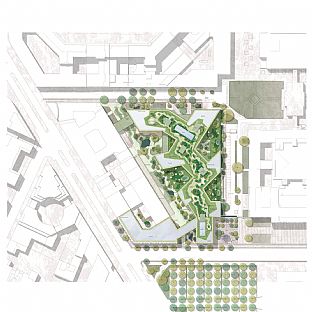Green flagship in Berlin
The 50,000 m2 extension of the ministry is housed on a triangular building plot bordered by the existing ministry buildings and the Abgeordnetenhaus (Berlin House of Representatives), and meets unusually high demands for sustainability and outdoor facilities in the centre of Berlin. C.F. Møller has transformed this into a wooden and natural stone proposal with integrated solar cells in the facade and a focus on daylight and green communal areas as a new and dynamic interpretation of the existing urban block.
“In this project, we have strived to create a balance and synergy between tradition and innovation. Our project takes its direct origins in Berlin's urban and building culture, which is both respected and complemented by an innovative statement on the sustainable architecture of the future,” says Julian Weyer.
The starting point is the classic and functional office interior, which is optimised in terms of daylight, natural ventilation and building geometry, to create excellent daylight conditions and secure attractive views from the office areas. The building will open onto the surrounding city and embrace green courtyards via a branch-like structure so that fresh air can enter, and employees can enjoy the green areas.
“Inspired by the logic and clarity of nature, we have created an architectural approach with a solid base and a clear relation to the urban context and a vibrant and dynamic building structure that - like a tree - opens up to the light and appears open and welcoming: an and creates an attractive and flexible framework for the workplace of the future,” says Michael Kruse.
Green and sustainable
Two atriums with glass and open stairways act as focal points in the project, connecting the office floors as well as a communal roof garden. On the individual floors, lounge areas in each office section form meeting places for use during breaks and for exchanging experiences and ideas. A conference centre and library on the ground floor have been developed to also function as an alternative workplace with a view to developing “New Ways of Working”. This ensures great flexibility, which over time can embrace different user needs.
The building's facades will also be made of timber and inspired by the diverse density of treetops as part of a multi-stranded, low-tech sustainability strategy that aims to reduce the CO2 footprint and improve comfort for users. By making solar panels an integral part of the facade of one building, the roof of the other is kept free for a large, green roof garden, which together with the green courtyards emphasises the ministry's environmental ambitions and its positive contribution to the city's development.
“It is our belief that the project will be able to help promote the development of innovative, sustainable and socially responsible architecture in which we very strongly believe and would like to contribute,” says Michael Kruse.
C.F. Møller Architects in Berlin
Winning the competition further continues C.F. Møller's strategic efforts to establish itself in Germany, which also led to the company opening an office in Berlin in 2019. The office is headed by Heiko Weissbach. In addition to working with BMU, C.F. Møller in Germany is also working on projects within housing construction, master planning, offices, campus projects as well as healthcare. Typically, work takes place in collaboration between the German office and the Danish offices. This creates Nordic values and traditions adapted to the German context and requirements for buildings.
BMU
BBR
Project Description
Media Kit

